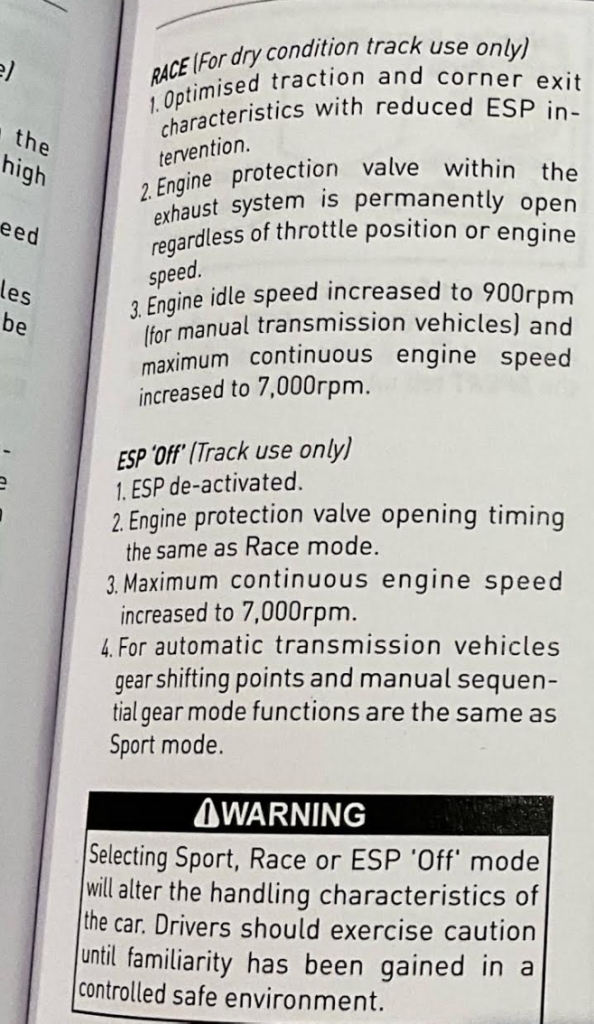
Lotus Elise, Exige, Emira, Evora electronic driving aids – a useful but incomplete guide
If your Lotus car was built any time after 2006 then it’ll probably have some sort of electronic driving aid built into it. And here I’m going to explain what those aids are…but given the fact that Lotus tend not to produce more than a hundred of anything without changing it in some way there will be generalisations.
The term ‘electronic driving aid’ means some sort of system that uses sensors to detect what the car is doing and then makes some sort of input to the car to change its behaviour. Here’s a summary of systems from an Evora, and we’ll through each in turn:

ABS – antilock braking. Detects when one or more wheel rapidly slows down relative to the rest which means it’ll lock, and then releases brake pressure slightly and momentarily to prevent that locking. ABS has a number of channels such as two or four which refer to the number of sensors; more the better, with four being ideal so one for each wheel. There now is also EBD, Electronic Brake Distribution, which distributes brake pressure across all four wheels – ABS by itself just prevents lockup.
Engine Traction Control (Lotus Traction Control)- this system detects wheelspin and reduces engine power to bring the wheelspin under control. Lotus have called this LTC, or Lotus Traction Control and it is described in my Elise 2012 manual:

It is important to understand that this system is not stability control which is described later in this article. LTC will not recover from or prevent oversteer or understeer; all it will do is cut the power if it detects excess power-on wheelspin.
Here’s another take on LTC from an Exige manual:

Brake Traction Control – this system monitors relative wheelspeed of the two driven wheels, and when one wheel begins to spin significantly faster than the other it is braked. The reason one driven wheel spins relative to the other is due to a difference in traction, and differentials unfortunately spin the wheel that’s easiest to turn, the one with least traction. So, Brake Traction Control brakes that wheel only which has the effect of delivering more torque to the other wheel which does have traction. You can see this explained in the video below which uses a 4WD, but the principle is the same for sports cars. Lotus do not appear to have their own name for this technology or refer specifically to it, but the system would be in vehicles that have ESC. This is from a 2017 Elise 220 Sprint manual:

Note that this description of traction control is now called simply Traction Control not Lotus Traction Control, and unlike the 2012 Elise manual, there is now a reference to braking a spinning wheel. The generic term for this system is Brake Traction Control.
The Evora above refers to a “Electronic Differential Lock” – I think this is just brake traction control, not a true mechanical axle locking differential. Marketing over engineering maybe!
ESC – Electronic Stability Control (Lotus Dynamic Performance, Electronic Stability Program) – this system monitors the car’s wheel speeds, driver inputs such as steering and throttle, yaw rate and much more. If it detects understeer or oversteer it will individually brake wheels and reduce throttle to keep the car from skidding. Lotus’ first ESC systems were around 2010 and they called it Lotus Dynamic Performance. This was later changed to the more generic name of Electronic Stability Program, and in the Emira manual it’s called Electronic Stability Control, the industry standard name.
This image shows the switch difference between LTC and ESC:

The two icons look similar. Don’t confuse LTC for ESC and be thinking you have a safety net that you don’t.
Some Lotus were also equipped with a variable engine traction control system which looks like this:

This is how it works:

To be clear, that’s engine traction control, aka Lotus Traction Control (LTC) which regulates how much wheelspin/slip is allowed before the electronics reduce power.

This from an Exige manual:

A warning that disabling ESP (aka ESC) will leave you on your own except for ABS. This is typical for cars and 4x4s; ABS can never be disabled.
DTC – Drag Torque Control – when you downshift a Lotus you will be engine-braking and thus applying braking force to the rear axle. This braking force may be enough to lock the rear wheels, known as compression lock. This is why people learn and use heel’and’toe shifting which I explain the in video below. However, if your Lotus has DTC then there it will provide a little throttle to mitigate this risk. It’s not clear which Lotus vehicles have DTC, but I suspect the later ones would feature it. This is not the same as automatic rev-matching on downshift which Lotus do not seem to have even on the Emira but is common on modern manual sports cars.
Sport button – some Lotus vehicles such as my own have a Sport button. On older models this just changes the throttle map to make the vehicle more responsive to throttle inputs. It does not deliver any more power. Here it is on my 2012 Elise S, along with the LTC button:

Contrast that with a similar year model where the button is labelled “SPORT DPM”, indicating that it switches Dynamic Performance Management (ESC) on and off:

Understeer detection – an ESC mode focused on understeer; reduces throttle and brakes indvidual wheels to reduce understeer.
Launch control – this is a silly function and I’m not going to bother describe it. An Exige manual says you can do only 20 launches before needing to call into your dealer to get yelled at for being an idiot. Or might say ask for a reset, not sure.
Driving Modes – later Lotus vehicles have various modes such as Tour, Sport, Race and Off, or in the case of the Emira at least; Tour, Sport, Track and Off. The difference between the modes is, in general, the amount of safety offered by the electronic systems. While ABS always remains active, the ESC system is de-sensitised so it allows more slip before it activates, and when it does activate it does so more gently. There may be other changes such as increasing the sensitivity of the throttle (like the Sport button in my 2012), raising the rev limit a little, changing the exhaust note and for automatics, changing the gearshift points to hold gears longer and downshift earlier. Here’s a summary of different modes:


Race Mode – this deserves special mention because it works quite differently to the other modes which allow a fixed amount of slip before intervention. Race mode starts from a high degree of slip – in other words, wheelspin and slide caused by applying power – and then works back to restrict the power input to the optimal. Race mode uses brake traction control, engine traction control and ESC which still remains active but is de-sensitised.


Reactive and Proactive -these are my terms to describe two categories of driving aids. The ‘reactive’ type only activates when there is trouble detected; wheelspin, potential wheel lockup, oversteer, understeer. It continues to act until the problem goes away. The ‘proactive’ type doesn’t wait for a problem; it actively helps the car corner and accelerate, and that is what is fitted to at least the Emira, possibly other vehicles. Using such aids should in theory make you faster; you simply press the throttle out of the corner and the car figures out exactly how much power can be applied, and it helps rotate the car into the corner and out of it. Whether you think that’s a good thing is an matter of opinion – my job is to inform so you can judge.
All of the above systems have been developed over decades, so the ABS of say 2006 is primitive compared to the ABS of 2023.

If you enjoy Lotus cars you might like to look at my Lotus shop designs – https://shop.l2sfbc.com/lotus-detail/



